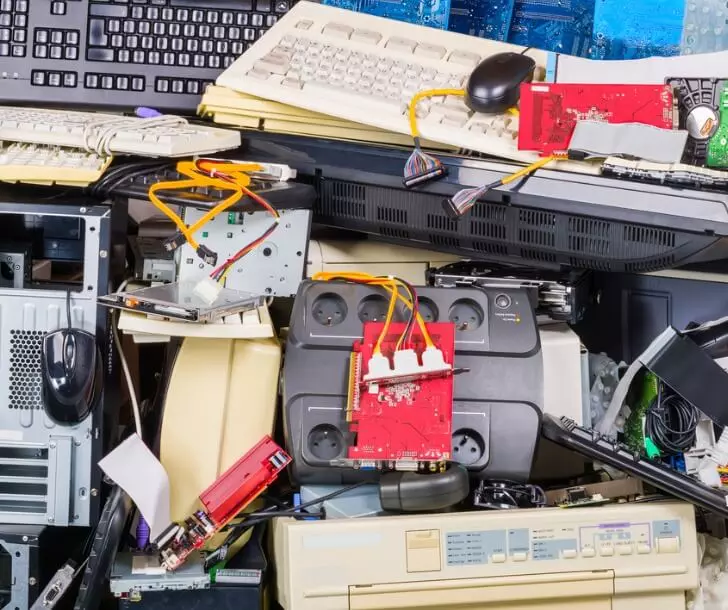
INDUSTRIAL ROBOTICS’S RESPONSE TO E-WASTE
E-waste, also known as RAEE (Rifiuti di Apparecchiature Elettriche ed Elettroniche) in italian or WEEE (Waste of Electric and Electronic Equipment) in english, consists of electronic devices that must be disposed because they’re broken or no longer working.
There are many in a company, if we only think that they include:
- Mobile phones
- Copy machines
- Printers
- Fax
- Landlines
- Computers
- Tablets
- Audio and video players
They are very common objects and they are subjected to intense wear and tear so they must be frequently dismissed and recycled in the correct way. The main problem is that it is special waste, because in some cases electronic parts can be very dangerous, for example cathode ray tube screens or computer parts containing heavy metals and toxic substances.
In other words, what makes this waste difficult to recycle is the presence of substances that are dangerous for the environment and components that are in no way biodegradable. Their polluting impact, therefore is potentially very high. It is clear that the goal worldwide must be to maximize recycling and robotic automations are the answer. Let’s see how.
Special and dangerous waste: handling them safely
The “danger” of this waste is not only towards the environment, but towards mankind itself as well, which includes staff designated to disposal. Every single material which electronic devices are made of must be retrieved following specific criteria to avoid a highly polluting and useless leakage, given that these resources are increasingly scarce in nature and perfectly reusable, such as:
- Copper
- Steel
- Aluminum
- Silver
- Gold
- Lead
- Mercury
- Iron
- Platinum
- Palladium
- Lithium
European statistics on e-waste’s recycling are still very variable from nation to nation and updated irregularly. However, as the use of technological tools in everyday business life increases, the percentage of produced e-waste increases proportionally.
Therefore, it is about handling recycling in an organized, fast and safe way, because we’re talking about a type of waste that will continue to grow at a sustained rate. Studies estimate that the per capita amount of electronic and electrical waste is about 6 kg every year. A number that should make us reflect, especially on a company and industrial level.
In this regard, a very interesting site to consult to realize the size of the e-waste problem on a global scale is globalewaste.org. The website The Global E-waste Statistics Partnership (GESP) is a partnership born between the International Telecommunication Union (ITU), the United Nations University (UNU) and the International Solid Waste Association (ISWA) to monitor e-waste development overtime and help states produce accurate statistics.
The industrial answer
It is clear that companies and industries are big e-waste producers and are also the parties to which governments are asking the most important changes in terms of containing the environmental impact derived from their activities.
Global warming is a hot topic right now and many companies have already changed their “bad habits” turning to a greener footprint in everyday company life. However, when talking about e-waste some complexities, such as proper classification of various materials and dismantling of various devices, arise.
Manually handling the recovery of this type of waste is unthinkable. The risks are too high and the execution time would be too long with managing costs that would rise out of proportion.
Instead, the answer may come from advanced automated robotic systems. In fact, in the past, the limit of automated management was the non-uniformity of the waste to be disposed of. Now research in the field of industrial robotics has found concrete solutions.
Robotics, e-waste and research
Faced with an obvious need for sustainable growth, we at Tera Automation are part of a plan for the study and development of an integrated process for the recovery and the recycle of raw materials from WEEE made in collaboration with Mediate Srl ( a spin-off of Sant’Anna’s superior school for reaserch and development, based in Pisa, ), Italimpianti Orafi S.p.a., Violi S.r.l. and University of Urbino’s Chemistry Department, a true network of companies and universities.
The goal is to make sure that once a complex waste, like electronic waste, is dismantled it could be used to build new feedstock for diversified fields, saving on natural and economic resources. industrial robotics and artificial intelligence are the way to go in order to make more precise and sophisticated the steps of selection and ordering of electronic components, which were once a critical aspect. Robotic manipulation can therefore guarantee works that until today only man could’ve done but that would also expose him to high levels of risk.
E-waste handling must be a part of some sort of supply chain that begins with acknowledging the electronic object through advanced vision systems and proceeds to recover all components and materials.
T-Flexicell: robotic cell for e-waste
We at Tera Automation have therefore rethought our robotic cells for manipulation T-Flexicell so that they’re able to sort electric and electronical waste as well.
But what do these cells physically look like? They have very similar looks to every other T-Flexicell for manipulation. They maintain their compact dimensions, inside them can be inserted both an anthropomorphic robot or a delta robot. Automation is then equipped with a 2D or 3D vision system for the selection and the distinction of components.
Based on the type of waste different solutions, of supplying, rejecting and collecting pieces can be studied.
